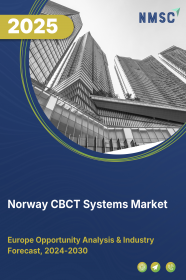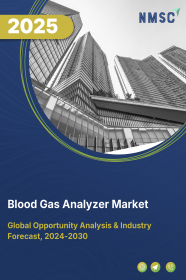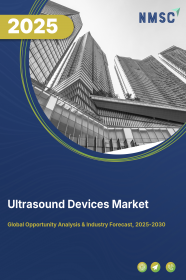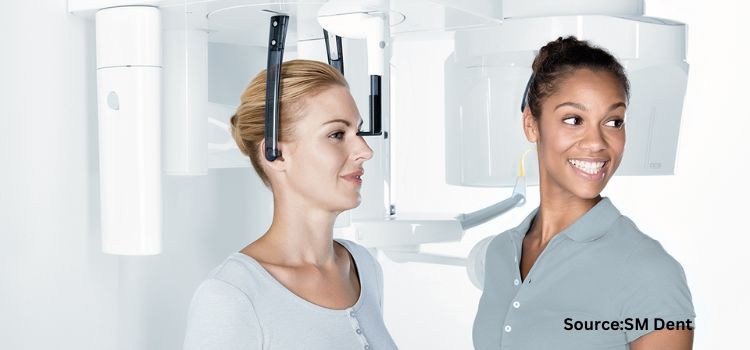
Norway Cone-Beam Computed Tomography (CBCT) Systems Market by Patient Position (Seated, Supine, and Standing), by Detector Type (Image Intensifier and Flat-Panel Detector), by Field of View (Small FOV Systems, Medium FOV Systems, and Large FOV Systems), by Application (Dental, ENT Applications, Orthopedic Conditions, Neural & Spine, Lung Cancer, and Veterinary) and by End User (Dental Clinics, Hospitals, and Others) – Opportunity Analysis and Industry Forecast, 2023–2030
Industry: Healthcare | Publish Date: 04-Mar-2025 | No of Pages: 81 | No. of Tables: 65 | No. of Figures: 33 | Format: PDF | Report Code : HC821
Market Definition
Norway Cone-Beam Computed Tomography (CBCT) Systems Market was valued at USD 5.86 million in 2022, and is predicted to reach USD 16.3 million by 2030, with a CAGR of 12.72% from 2023 to 2030. Cone Beam Computed Tomography (CBCT), known by various names such as C-arm CT, cone beam volume CT, flat panel CT, or Digital Volume Tomography (DVT), is a specialized medical imaging method employed to generate three-dimensional images of different anatomical structures within the human body. This technique involves the use of a cone-shaped X-ray beam that revolves around the patient, capturing a sequence of two-dimensional X-ray images from multiple angles.
Subsequently, a computer reconstructs these images to produce intricate 3D depictions of the scanned region. CBCT technology finds widespread application in fields such as dentistry, oral and maxillofacial surgery, and orthodontics, offering a comprehensive perspective of the teeth, jaws, facial bones, and adjacent tissues. With its ability to capture images characterized by high spatial resolution and minimal distortion, CBCT enables healthcare practitioners to visualize anatomical structures with exceptional precision and accuracy.
The advantages of CBCT over traditional medical imaging techniques, such as conventional X-rays or CT scans, include lower radiation exposure, shorter scan times, and the ability to produce high-quality 3D images. This technology enables healthcare providers to plan and perform complex dental and surgical procedures more effectively, facilitating accurate diagnosis, treatment planning, and evaluation of treatment outcomes.
Thus, CBCT is an advanced imaging technique that employs cone-shaped X-ray beams and computer algorithms to generate detailed three-dimensional images of the human body, primarily used in dental and maxillofacial applications for improved diagnosis and treatment planning.
Increased Healthcare Expenditure by Norwegian Government Set to Propel CBCT Market Growth
The Norwegian government's growing healthcare expenditure aimed at improving healthcare infrastructure and advancing disease identification, and prevention, is expected to drive the expansion of the CBCT market. For instance, according to the International Trade Administration, Norway is one of the top healthcare spenders in the world, with the country's healthcare expenditure reaching USD 43 billion or USD 7900 per citizen in 2021.
This increased investment reflects Norway's commitment to enhancing healthcare services and facilitating accurate diagnostic procedures, which in turn will contribute to the growth and adoption of advanced diagnostic tools including CBCT.
Rising Elderly Population in Norway Boosts CBCT Demand for Dental and Orthopedic Care
The increasing number of elderly individuals in Norway is fueling the need for CBCT. CBCT can be valuable in assessing and planning dental and bone-related treatments for older individuals. As people age, they may experience dental issues such as bone resorption, dental implant requirements, knee and hip implantation, and others. CBCT can aid in diagnosing these conditions and determining the best course of treatment.
According to the recent World Bank report, the percentage of people aged 65 and above in Norway reached 18% in 2021, highlighting the significance of efficient diagnostic tools to cater to the growing geriatric population's healthcare needs.
High Cost of Cone-Beam Computed Tomography (CBCT) Systems Machines in Norway
The considerable expense associated with Cone Beam Computed Tomography (CBCT) machines can pose a notable impediment to the expansion of the CBCT market. The substantial initial investment needed to procure CBCT machines can dissuade healthcare facilities, especially smaller clinics or practices with constrained financial resources. This cost encompasses not just the acquisition of the machine but also includes expenses related to installation, maintenance, and training.
The financial burden associated with CBCT machines can limit their adoption, especially in regions with resource constraints or in healthcare settings where budget allocations are tight. This can restrict the availability and accessibility of CBCT technology, hindering its widespread implementation in various healthcare facilities.
Technological Advancements in CBCT Systems Market in Norway: A Promising Opportunity for Growth
Incorporating Artificial Intelligence (AI) into CBCT software has the capacity to transform the imaging field and substantially augment the capabilities of CBCT technology. Through AI algorithms, CBCT software can analyse and interpret images with heightened precision and effectiveness.
These algorithms can be trained to automatically detect and segment anatomical structures, lesions, and abnormalities, providing valuable insights to clinicians. By automating these tasks, AI integration can save time and improve diagnostic accuracy, ultimately leading to more effective treatment planning.
Additionally, AI-powered CBCT software can simulate and visualize treatment outcomes, enabling clinicians to better plan and communicate treatment options with patients. Whether it's virtual implant placement, orthodontic treatment simulations, or surgical planning, the integration of AI in CBCT software offers new possibilities for personalized and optimized patient care. It holds the promise of streamlining workflows, reducing manual labor, and enhancing the overall efficiency and precision of CBCT imaging in various medical and dental applications.
Competitive Landscape
The Norway Cone-Beam Computed Tomography (CBCT) Systems industry includes several market players such as Dentsply Sirona, Koninklijke Philips N.V., Vatech Co., Ltd, Envista Holdings, Planmeca OY, J. Morita Mfg. Corp., Cefla S.C., Hefei Meyer Optoelectronic Technology INC, Xoran Technologies LLC, Acteon Group, Hitachi Ltd., Genoray Co Ltd, Asahi RoEntgen Ind. Co. Ltd., OSSTEM IMPLANT CO., LTD., Largev Instrument Corp. Ltd., Carestream Dental LLC, Curvebeam AI, and HDXWILL.
Key Benefits
-
The Norway Cone-Beam Computed Tomography (CBCT) Systems market report provides a quantitative analysis of the current market and estimations through 2023-2030 that assists in identifying the prevailing market opportunities to capitalize on.
-
The study comprises a deep dive analysis of the market trend including the current and future trends for depicting the prevalent investment pockets in the market.
-
The information related to key drivers, restraints, and opportunities and their impact on the market is provided in the report.
-
The competitive analysis of the market players along with their market share in the Norway Cone-Beam Computed Tomography (CBCT) Systems market.
-
The SWOT analysis and Porter’s Five Forces model are elaborated in the study.
-
Value chain analysis in the market study provides a clear picture of the stakeholders’ roles.
Norway Cone-Beam Computed Tomography (CBCT) Systems Market Key Segments
By Patient Position
-
Seated
-
Supine
-
Standing
By Detector Type
-
Image Intensifier
-
Flat-Panel Detector
By Field of View
-
Small FOV Systems
-
Medium FOV Systems
-
Large FOV Systems
By Application
-
Dental
-
ENT Applications
-
Orthopedic Conditions
-
Neural & Spine
-
Lung Cancer
-
Veterinary
By End User
-
Dental Clinics
-
Hospitals
-
Others
Key Players
-
Dentsply Sirona
-
Koninklijke Philips N.V.,
-
Vatech Co., Ltd
-
Envista Holdings
-
Planmeca OY
-
J. Morita Mfg. Corp.
-
Cefla S.C.
-
Hefei Meyer Optoelectronic Technology INC
-
Xoran Technologies LLC
-
Acteon Group
-
Hitachi Ltd.
-
Genoray Co Ltd
-
Asahi RoEntgen Ind. Co. Ltd.
-
OSSTEM IMPLANT CO., LTD.
-
Largev Instrument Corp. Ltd
-
Carestream Dental LLC
-
Curvebeam AI
-
HDXWILL
REPORT SCOPE AND SEGMENTATION:
|
Parameters |
Details |
|
Market Size in 2022 |
USD 5.86 Million |
|
Revenue Forecast in 2030 |
USD 16.3 Million |
|
Growth Rate |
CAGR of 12.72% from 2023 to 2030 |
|
Analysis Period |
2022–2030 |
|
Base Year Considered |
2022 |
|
Forecast Period |
2023–2030 |
|
Market Size Estimation |
Million (USD) |
|
Growth Factors |
The growing healthcare expenditure. The increasing number of elderly individuals. |
|
Companies Profiled |
18 |
|
Market Share |
Available for 18 companies |
|
Customization Scope |
Free customization (equivalent up to 80 working hours of analysts) after purchase. Addition or alteration to country, regional, and segment scope. |
|
Pricing and Purchase Options |
Avail customized purchase options to meet your exact research needs. |

















 Speak to Our Analyst
Speak to Our Analyst





















